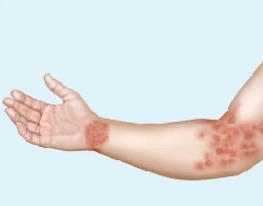About Us

Nummular Dermatitis
Nummular Dermatitis, also known as Discoid Eczema, is named so because of the coin-shaped and well-defined appearance of the itchy, oozy patches. Occasionally, they do not present with oozing or ‘weeping’ lesions, and are then referred to as Dry Discoid Dermatitis (DDD).
It is one of the variants of Eczema and is seen in about 5-10% of the population. It commonly affects the elderly. When it happens in childhood, it may be a manifestation of Atopic Dermatitis. The exact cause may not always be identified, but some of the proposed triggering factors include
- Dry skin and winters
- Emotional Stress
- Atopic Eczema, Asthma or Hay fever
- Over reaction of the immune system to bacteria
- Specific allergens like metal, dyes, fragrances etc.
- Friction
It usually begins as itching and coin-shaped areas of redness. Within a day or two, you will notice small fluid-filled blisters, which on itching start to weep. These dry with crusting and scaling. Eventually, the lesion starts clearing out in the center while persisting in the borders.
This may then mimic a fungal infection (commonly referred to as ‘Ring Worm’). They are common on the back of the hands, forearms, legs and buttocks. They are not contagious. But if ignored, the raw oozy areas may get infected. They eventually heal leaving dark areas, which gradually fade away.
When nummular dermatitis occurs repeatedly, a patch test or some blood tests may be required to identify the cause. In most cases, nummular eczema tends to be a chronic problem.

